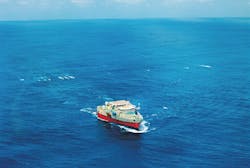Seismic survey contractors hoping for turnaround
Outlook for this year mixed, uptick possible
Bruce Beaubouef
Managing Editor
Demand for new seismic data could increase if oil prices remain at current levels or rise. (Courtesy CGG)
Of all the sectors affected by the downturn, the marine seismic survey market has perhaps been the hardest hit. Companies that have served the market for years have declared bankruptcy, and others have announced their intention to exit the market.
CGG filed for bankruptcy in France and the US in 2017 in a move to eliminate $1.95 billion in debt from its balance sheet. Global Geophysical Services filed for bankruptcy in 2016, its second time in two years. Seismic surveyor Dolphin Group filed for bankruptcy in 2015. Many companies in the market have seen their share prices crash since 2015, in some cases by over 90%. And in January, Schlumberger announced that its WesternGeco business unit would exit the land and marine acquisition business.
But a number of marine seismic survey companies have taken steps to significantly reduce their cost base and are now reporting increased levels of tendering activity. With the recent rebound in oil prices, contractors and service providers are hopeful that the market will turn around this year.
Polarcus and PGS officials have indicated that there could be improved tender activity in 1Q and 2Q 2018, with even greater utilization in the second half of the year. Both companies have noted that improved demand for marine seismic projects often signals the beginning of an upturn in the market.
Speaking at the Pareto Securities Oil & Offshore conference last September, Polarcus officials said that overall marine seismic activity is picking up. PGS officials said that they are seeing growing demand for multi-client activity and in production seismic projects.
With the stabilization of oil prices, operators and E&P firms are beginning to sanction projects based on their capex guidance issued at the beginning of 2017. As a result, Polarcus says that tender activity has increased from its historically low levels; and in 3Q 2017, the company received the greatest number of tenders it had seen since 2Q 2015. There has been a 50% increase in sq km of surveys tendered in 2017 compared to 2016, Polarcus officials said. Activity is returning to new and dormant basins, with work being especially active offshore West Africa and the Guyana-Suriname basin. There are some signs of resurgence in the Asia/Pacific region as well. In December, thePolarcus Naila left Singapore for a seismic survey job in the Bonaparte basin, off Australia’s northwest coast.
For its part, PGS said that its focus on multi-client surveys had brought greater stability to its business despite the cyclical nature of the market. Company officials say that the proportion of its work that is multi-client will continue to increase going forward. PGS also said that it anticipates the number of production seismic (4D) projects to increase further in 2018. Notable areas of growing 4D activity are the North Sea, West Africa, and Brazil.
Multi-client surveys
Multi-client surveys may in fact represent the bulk of seismic survey work taking place in the offshore market these days. In December, TGS reported that it will expand its 3D seismic coverage in the deepwater Gulf of Mexico with the Alonso 3D multi-client survey. This will be a survey of 6,172 sq km (2,383 sq mi) located in the Atwater Valley and Lloyd Ridge protraction areas of the US Gulf of Mexico. Multi-level targets exist, from Miocene to Jurassic.
This project, the company claims, allows it to extend coverage from a core area in Mississippi Canyon into a more frontier area that is experiencing renewed interest from E&P companies. TGS will acquire new 3D data to provide the higher spatial resolution required to delineate multiple plays at multiple levels.
PGS says that it expects the number of production seismic (4D) projects to increase in 2018. (Courtesy PGS)
Acquisition activities were expected to begin in February 2018. Data processing will be performed by the company using its Clari-FiTM broadband technology. This survey is supported by industry funding.
Other marine seismic companies are participating in multi-client surveys as well. Earlier this year, Polarcus announced that it had extended its collaboration agreement with TGS-NOPEC by a further year. The companies will continue to jointly develop selected 3D multi-client projects, and TGS will prolong its vessel commitment with Polarcus to the end of 2018 for up to 10,000 sq km (3,861 sq mi).
One project covered under this commitment is the recently announced XArray project in the Gulf of Mexico. For this project, Polarcus acquired over 15,000 sq km (5,791 sq mi) of broadband 3D seismic data for TGS during 2017. The collaboration will further drive vessel utilization in 2018, Polarcus officials say.
Spectrum, on behalf of the Institute of National Petroleum, says it has started a 2D multi-client seismic survey offshore Mozambique. This new 2D seismic program of up to 19,000 km (11,806 mi) will be undertaken using a 10,000-m (32,808-ft) offset with continuous recording to enable extended recording lengths and high fold data. Gravity and magnetic data will be acquired in conjunction with seismic data to allow for independent verification of structure.
The survey is specifically designed to image the subsurface potential in the southern Rovuma basin and the western flanks of the Kerimbas Graben, west of the Davie Fracture Zone, providing a more detailed understanding of the prospectivity in this region. Potential targets, identified following recent studies in the area, include Cretaceous and Tertiary turbidites and buried canyon plays.
The survey will also image the syn-rift structures and Late Cretaceous pro-delta stacked turbidite sequences in the northeast Zambezi Depression. The data will be processed with PSTM, PSDM, and broadband products with first deliveries in early 2Q 2018. This survey will be carried out in partnership with WesternGeco and is supported by industry funding. The survey is being acquired to complement existing 2013 seismic located in the Mozambique Channel area.
Difficulties remain
But while work is underway on several projects, dark clouds still hover over the seismic survey market. Analyst firm Wood Mackenzie says that exploration investment is expected to remain suppressed and exploration budgets tight in 2018 despite a brighter price outlook. In a recent report focused on the deepwater US Gulf, the firm wrote that “while 2018 promises to be a record-setting one for the region in terms of production, exploration activity is expected to remain flat.”
For Schlumberger, it was this type of market outlook that led it to exit the seismic survey marketplace. The company made the announcement regarding its WesternGeco business unit while reporting its 4Q 2017 financial results in mid-January. In the announcement, chairman and CEO Paal Kibsgaard noted that “geophysical measurement, survey design and seismic operations have been an essential part of Schlumberger and our R&E [research and engineering] efforts for more than 30 years.” But as the downturn entered a sixth year for the seismic data acquisition business, Kibsgaard said that “the present outlook provides no line of sight for the market recovery.”
Kibsgaard said that he believed that Schlumberger’s seismic acquisition business could not provide the desired full-cycle returns or compete internally for funding. “Based on this in-depth analysis,” Kibsgaard commented, “the only product line that does not meet our return expectations going forward, even factoring in an eventual market recovery, is our seismic acquisition business.”
Schlumberger says that going forward, its WesternGeco unit will adopt an asset-light model based on its multi-client data processing and interpretation businesses. The company says it plans to honor its existing contracts and customer commitments and cold stack equipment as it evaluates divestment options.
The squeeze in the seismic survey market comes as the industry continues to make major technological strides, including advances in high-performance computing, nodal technology, broadband seismic, data analytics, and machine learning. This may be more than just coincidence – these advances are enabling operators and developers to extract higher value from acquired data. Given the current emphasis upon capital efficiency, this trend may help create an expectation of getting the same or better information in a more cost-effective way. It would seem that the advance of technology, along with the market downturn, is working to keep the market tight and opportunities light.
Going forward, some analysts have noted that operators are signaling continued caution on the extent of exploration spending in 2018. Demand for new seismic data will therefore likely remain weak this year, from a historical perspective, although there could be an upturn if the oil price remains at the current level or rises as the year progresses. Seismic survey companies can only hope that projections of better times later this year and into next come to fruition.


